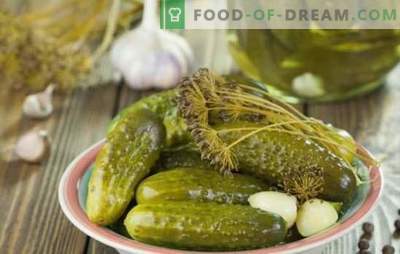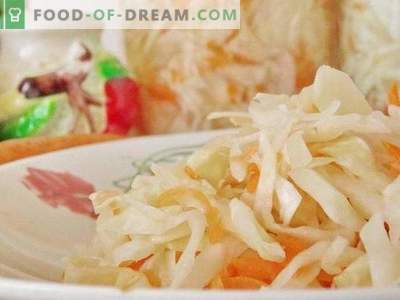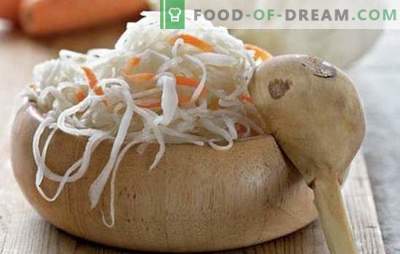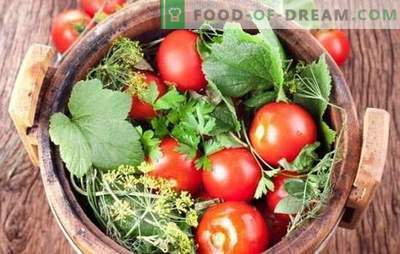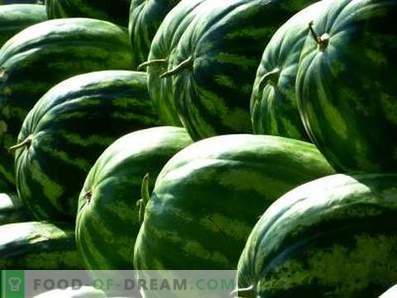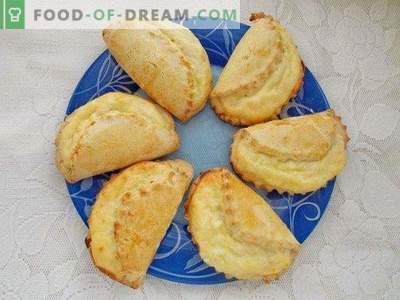- Preparations for the winter according to old recipes. Part 1
Now, when readers are slightly immersed in the processes of fermentation, pickling and urinating of vegetables, fruits and berries, let us summarize some results and report a few more recipes. So, all these processes are based on the lactic fermentation of sugars of the original product. The lactic acid accumulated at the same time not only gives the finished product a unique taste, but also acts as an antiseptic, inhibiting the activity of harmful microorganisms and thus preventing the deterioration of the product. It is believed that there is no fundamental difference between souring, salting and urinating, and the finished product is called sauerkraut (cabbage), salted (cucumbers, tomatoes, etc.) or soaked (apples, pears, lingonberries and many other fruits and berries) depending on the type raw materials. When fermentation accumulates more lactic acid (up to 1, 8%), more salt is added during salting (pour vegetables with 5-7% concentration of brine), which corresponds to the salt content in the final product 3, 5-4, 5%. Some sources recommend to store all the harvested in vivo by pickling, pickling, urinating at 0 ° C, others give higher ranges of storage temperatures.
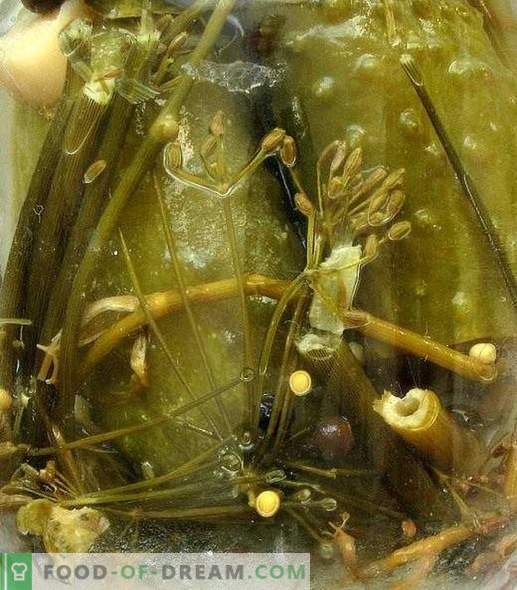
A few words about the benefits of such products.
Experts say that pickled vegetables and fruits are even healthier than their fresh counterparts. They completely preserve vitamin C, which is actively destroyed during storage of unprocessed fruits. 70-80% of other vitamins and 80-90% of microelements are also stored in pickled fruits. As a result of the fermentation of sugars, lactic acid is formed, which does not allow microorganism pests to develop. Enzymes contained in fermented, salted and pickled vegetables, fruits and berries activate metabolic processes, facilitate the digestion of fatty and meat dishes, and improve the cleansing abilities of our body. That is why in the blanks without adding vinegar, not only the vegetables themselves, but also the pickle are valuable. It is believed that cabbage pickle is a “byproduct” of pickling - an excellent “mixture” for gastritis and a wonderful fat burner. It can and should be used as an additive in soups (instead of salt), salads (as a dressing) and as a drink that is served during meals. It should be remembered that the rapid fermentation affects the taste of fermentation, and slow (at temperatures below 15 ° C) gives bitterness.
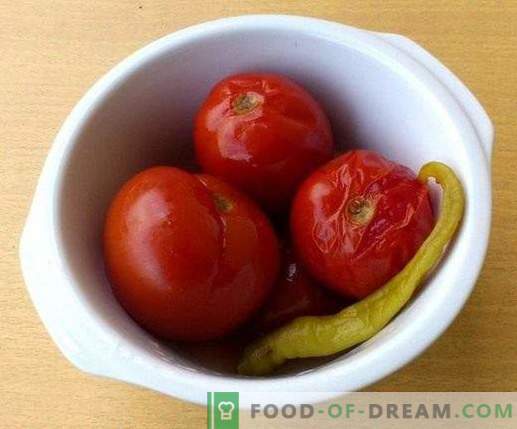
Many people are interested in - is it possible to use lotions, pickled and salty products for weight loss? Experts answer: you can. For example, soaked apples are characterized by low calorie and high fiber content, so it is acceptable to use them during a diet. They practically have no proteins, so apples do not affect the growth of muscle mass, but you can get rid of fat deposits with their help.
How to pickle watermelons.
Who among us does not love this unique berry of extraordinary sizes, shapes and unique taste. Even if this taste changes during the salting of watermelons on the diametrically opposite, from slightly sweet to salty, it remains as unobtrusively pleasant as ever. If you have never salted watermelons in a barrel, and were limited to only banks, then be sure to try. It is not difficult at all, but you can always enjoy the salty whole berries from the hot summer. Oak, lime or cedar barrel of about 100 liters, thoroughly washed and dried in the sun, will be suitable for salting. Alternatively, you can use a plastic container for food. First you need to carefully select the watermelons (in our case, about 15 - 20 pieces). They should not have cracks, dents and rot stains. It is better if they are not over-ripe or green. It is advisable to salt fine-grained varieties of medium size. Some experts in this matter recommend pinning each watermelon in about ten places with a needle or a toothpick, ostensibly to speed up the salting process, although others subject this procedure to doubt. Next, the selected watermelons should be washed under running water and remove the stem. For salting watermelons suitable 6-8% saline solution, i.e., 600-800 grams of table salt should be dissolved in 10 liters of clean water. You should also add to the solution a couple of glasses of sugar and a few tablespoons of mustard powder. Watermelons are placed in a cooked barrel and poured brine. You can make salting combined, that is, add chopped cabbage, apples, suitable for urinating, unripe tomatoes into a barrel. The added components should first of all be lined with the bottom of the barrel with a layer thickness of up to 10 cm. Then, using combined products, each row of watermelons is shifted, but not reaching a couple of centimeters to the edges of the barrel walls. Next you need to cover all this with a wooden circle and put pressure on it. Salting should be 15-20 days in a cool place (15-20 degrees. C). Periodically, it is recommended to remove the lid and, if there are signs of mold growth, remove the mold and add fresh brine. Ready salted watermelons should preferably be consumed before spring warming, since by this time they will begin to lose their unique taste.
Cabbage.
We consider it necessary to report additional data about sauerkraut. The simplest ingredients for souring 10 kg of slaw are as follows: carrots - 1 kg, salt - half a glass, sugar - one glass, fennel seeds - half a glass (available with halos). Cabbages are desirable to have dense, white and strong. Chopped cabbage should be slightly mashed, carefully rub with salt and sugar. Then the cabbage is mixed with carrots, chopped on a conventional vegetable grater, lay in a tub and tamped. From above you can put cabbage leaves. Next, cover the cabbage with a clean cloth or gauze, folded in several layers, and put a circle with oppression so that the released juice covers the cabbage for the entire shelf life. In order for the cabbage to be crispy, the temperature during fermentation must be within 15-20 degrees. C. A sign of the beginning of the fermentation is the appearance of bubbles and foam on the surface. It is not necessary to pierce the whole mass of cabbage with a knitting needle or a skewer, as oppression will contribute to fermentation. The disappearance of foam means its ending and that it is time to transfer the container of cabbage to the basement or other cooler place.
Other pickles
Fans of homemade preparations can be advised to ferment pre-blanched eggplants with various fillings: cabbage, carrot, etc. As spices, you can use onions, garlic, carrots, celery. Supplements, except cabbage, should be extinguished before the fire. Eggplants are blanched for 5 minutes in boiling salted water (1 tablespoon of salt for 1 liter of water).
So that our readers have more opportunities for creativity in the production of home-made blanks for the winter, we recall once again the concentration of brines. When salting tomatoes in tubs: for green and brown tomatoes - 700-800 grams of salt per 10 liters of water; for pink, red and large tomatoes - 800-1000 grams per 10 liters of water. When salting cucumbers in tubs, the following brine is used: 600 grams of salt is taken for 10 liters of water. Do not forget about the spices: dill, tarragon, a little red pepper, a head of garlic, horseradish root. Try adding coriander, basil, Bogord herb, mint, etc. We have already spoken about supplements such as cherry leaves, black currant leaves, and oak leaves.
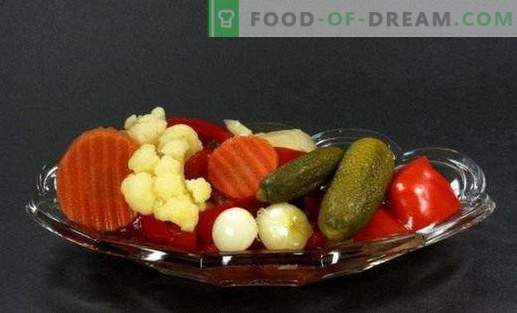
In addition to apples and thorns, about which we wrote, you can soak many other berries and fruits. For example, cranberries, pouring it at the rate of 1 liter of water, 4 tbsp. spoons of sugar, 2 tsp of salt, a few peas allspice and a little cloves. Pears can also be soaked if they do not suit your taste in their natural form. Brine: 200 grams of salt is put on 8 liters of boiled water. As spices, leaves of cherry, black currant, tarragon herbs, etc. are used. Sugar is added depending on the taste of pears. If you want to try the soaked red currants, then you will not have to regret the sugar in the brine. For 1 kg of red currant, 4 glasses of water, 2 glasses of sugar are recommended, and then cinnamon, cloves, etc., you can try soaking and rowan. For 1 liter of water 50 grams of sugar. Cinnamon and cloves are also used. Rowan removed from the brush well frostbitten. It must be well washed and poured into cooked dishes. Fill the need to cook, adding to it sugar and spices, cool and pour it rowan. Further, as usual: cloth or gauze, circle, oppression, the first 7 days the temperature is about 20, then the basement or something like that. Wet cowberries - nothing is easier. For 1 liter of water 1-2 tbsp. spoons of salt, 2-3 tbsp. spoons of sugar, allspice, cinnamon. Berries to sort, wash in cold water, pour in cooked dishes. Dissolve salt and sugar in water, bring to a boil. To improve the taste, we recommend adding peeled slices of fragrant apples. What to do next, you already know (see previous recipe). We believe that now the readers are well aware of the principles of salting, pickling and urinating. It only remains to try, experiment and create. We wish you success!


